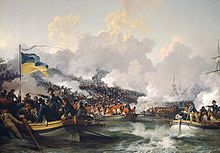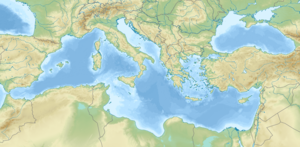The Battle of Abukir of 8 March 1801 was the second pitched battle of the French campaign in Egypt and Syria to be fought at Abu Qir on the Mediterranean coast, near the Nile Delta.
| Battle of Abukir | |||||||
|---|---|---|---|---|---|---|---|
| Part of the French Campaign in Egypt and Syria during the War of the Second Coalition | |||||||
 The landing of British troops at Aboukir, 8 March 1801 by Philip James de Loutherbourg | |||||||
| |||||||
| Belligerents | |||||||
|
|
| ||||||
| Commanders and leaders | |||||||
|
Ralph Abercromby Sidney Smith | Louis Friant | ||||||
| Strength | |||||||
| 6,000[1] | 1,800[2]–2,500[3] | ||||||
| Casualties and losses | |||||||
| 740 killed, wounded, or missing[3] | 400 killed, wounded, or missing[3] | ||||||
Location within Mediterranean | |||||||
The landing of the British expeditionary force under Sir Ralph Abercromby was intended to defeat or drive out an estimated 21,000 remaining troops of Napoleon's ill-fated invasion of Egypt. The fleet commanded by Baron Keith included seven ships of the line, five frigates and a dozen armed corvettes. With the troop transports, it was delayed in the bay for several days by strong gales and heavy seas before disembarkation could proceed.[4]
The Landing
editIn the early morning of the 8th March 1801, the landing force consisting of Flank companies of the 40th and the Welsh Fusiliers on the right. In the centre the 28th, 42nd and 58th. On the left, the Brigade of Guards, (formed from a battalion of each regiment) The Corsican Rangers, The Royals and 54th. The landing force totaled 5,230 men. All troops were on board the landing boats by 2 am. Its sailors tightly packed with muskets between their knees, the boats rowed silently to the rendezvous, each were placed in their positions of landing. By 8 am, each brigade was in place. At 9 am, a rocket fired from the Admirals ship signaled the advance and the boats sprang forward. With protection from light armed vessels, ketches and bomb brigs moored broadside to the beach, the troops beached their craft under a rainstorm of French cannonade and musket fire from 2,500 French positioned on the high dunes. The troops disembarked, formed line, fixed bayonets and advanced undaunted by the enemy fire. With General Moore leading at their head they struggled up the steep soft sandy ground. The French appeared at the summit and poured a destructive musket volley. The lead troops of the 42nd reached the summit before the French could reload and launched a bayonet charge, hurling them back in confusion. The French counter attacked with a squadron of cavalry, a second bayonet charge by the 42nd caused them to flee. On the left the Guards were attacked by cavalry and the 54th by Infantry bayonet. Both attacks were brilliantly repulsed. The British were now in control of the shore and advanced to expand the bridgehead. The French deserted their guns. A decisive victory by the British Expeditionary Force. By evening The Navy had landed the remainder of the Army and consolidated control at Aboukir.[5]
Summary
editThe French garrison of Alexandria under General Friant, some 2,000 French troops and ten field guns in high positions took a heavy toll of a large British force disembarking from a task-force fleet in boats, each carrying 50 men to be landed on the beach. The British then rushed and overwhelmed the defenders with fixed bayonets and secured the position, enabling an orderly landing of the remainder of their 17,500-strong army and its equipment. The skirmish was a prelude to the Battle of Alexandria and resulted in British losses of 730 killed and wounded or missing. The French withdrew, losing at least 300 dead or wounded and eight pieces of cannon.[4]
Napoleon later described the British landing as "one of the most vigorous actions which could be imagined".[6]
Orders of battle
editBritish
edit| Brigade and commander | Regiment | Number of men | Ref. |
|---|---|---|---|
| First line | [7] | ||
| Brigade of Guards Major-General George Ludlow |
1st Battalion, Coldstream Regiment of Foot Guards | 766 | |
| 1st Battalion, Third Regiment of Foot Guards | 812 | ||
| 1st Brigade Major-General Eyre Coote |
2nd Battalion, 1st Regiment of Foot | 626 | |
| 1st Battalion, 54th Regiment of Foot | 974 (combined) | ||
| 2nd Battalion, 54th Regiment of Foot | |||
| 92nd Regiment of Foot | 529 | ||
| 2nd Brigade Major-General John Cradock |
8th Regiment of Foot | 439 | |
| 13th Regiment of Foot | 561 | ||
| 18th Regiment of Foot | 411 | ||
| 90th Regiment of Foot | 727 | ||
| Second line | |||
| 3rd Brigade Major-General Lord Cavan |
1st Battalion, 27th Regiment of Foot | Left sick at Gibraltar and Malta | |
| 2nd Battalion, 27th Regiment of Foot | |||
| 50th Regiment of Foot | 477 | ||
| 79th Regiment of Foot | 604 | ||
| 4th Brigade Brigadier-General John Doyle |
2nd Regiment of Foot | 530 | |
| 30th Regiment of Foot | 412 | ||
| 44th Regiment of Foot | 263 | ||
| 89th Regiment of Foot | 378 | ||
| 5th (Foreign) Brigade Brigadier-General John Stuart |
Stuart's Regiment | 929 | |
| De Roll's Regiment | 528 | ||
| Dillon's Regiment | 530 | ||
| Reserve | |||
| Major-General John Moore Brigadier-General Hildebrand Oakes |
23rd Regiment of Foot | 457 | |
| 28th Regiment of Foot | 587 | ||
| 42nd Regiment of Foot | 754 | ||
| 58th Regiment of Foot | 469 | ||
| 40th Regiment of Foot | 250 | ||
| Corsican Rangers (flank companies) | 209 | ||
| Cavalry | |||
| Brigadier-General Edward Finch | 11th Light Dragoons (one troop) | 53 | |
| 12th Light Dragoons | 474 | ||
| 26th Light Dragoons | 369 | ||
| Hompesch's Hussars | 138 | ||
| Artillery | |||
| Brigadier-General Robert Lawson | 13th Artillery Company | 627 | |
| 14th Artillery Company | |||
| 26th Artillery Company | |||
| 28th Artillery Company | |||
| 55th Artillery Company | |||
| 69th Artillery Company | |||
| 70th Artillery Company | |||
| 71st Artillery Company | |||
French
edit| Unit | Number of men | Ref. |
|---|---|---|
| Cavalry | [8] | |
| 18th Dragoons | 115 | |
| 20th Dragoons | 80 | |
| Infantry | ||
| 61st demi-brigade | 680 | |
| 75th demi-brigade | 950 | |
| 51st demi-brigade | 210 | |
See also
edit- Battle of the Nile or Battle of Abukir Bay (1798)
- Battle of Abukir (1799)
Citations
edit- ^ Clodfelter (2017), p. 106.
- ^ Clodfelter 2017, p. 86.
- ^ a b c Divall (2018), p. 83.
- ^ a b Cust (1862), pp. 68–69.
- ^ Dundee Courier 07 April 1876 p.7 accessed 6 September 2023.
- ^ Phipps Vol 5 p.433, quoting Corr.Nap. XXX. 166-7
- ^ Mackesy (2010), pp. 70–71.
- ^ Mackesy (2010), p. 62.
References
edit- Cust, Sir E. (1862). Annals of the Wars of the 19th Century. Vol. 1. London: John Murray.
- Clodfelter, M. (2017). Warfare and Armed Conflicts: A Statistical Encyclopedia of Casualty and Other Figures, 1492-2015 (4th ed.). Jefferson, North Carolina: McFarland. ISBN 978-0-7864-7470-7.
- Divall, Carole (2018). The British Army in Egypt 1801. Warwick: Helion. ISBN 978-1-911628-14-9.
- Mackesy, Piers (2010). British Victory in Egypt. London: Tauris Parke Paperbacks. ISBN 978-1-84885-472-7.
- Phipps, Ramsay Weston (1926), The Armies of the First French Republic and the Rise of the Marshals of Napoleon I, London: Oxford University Press.
.
External links
edit- Media related to Battle of Abukir (1801) at Wikimedia Commons
